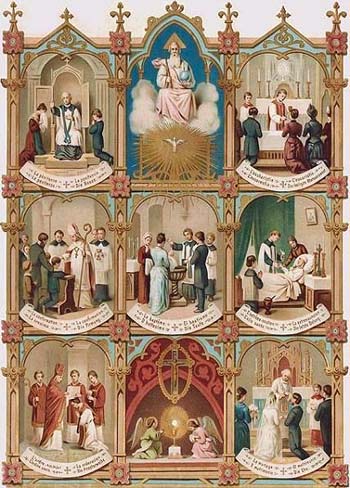Catholic Virtues
 |
 |
 |
 |
 |
 |
 |
The Single Vocation - VI - Objections
Conception of Children through the Word
Contradicts Marriage as Blessed by the Church
When answering the first objection to TIA’s articles on virginity and the celibate vocation, I showed that the way Our Lord Jesus Christ was conceived and born was clearly different from the way human nature multiplies after the original sin of our first parents.
Those statements raised problems that I will address now, continuing with my intent to respond to many objections on TIA’s stand on virginity and the celibate vocation as being more elevated and nobler than marriage.
Second objection:
1. St. Paul in union with the Church affirm that the model for human marriage is the spousal relation between Christ and the Church.
2. Now then, this marriage about which the Church speaks has sexual relations between the spouses to produce its offspring.
3. Therefore, the sexual relations in a Catholic marriage to generate children are blessed by the Church in both its specific goal of having offspring and in offering the nuptial relation of Christ and the Church as its model.
4. This conclusion undermines the thesis that conception before the original sin could have been accomplished by the word instead of by sexual relations.
Answer to the second objection:
1. This second objection is correct in most of its presentation. In other words, after original sin, the normal way to conceive children is through sexual relations within a legitimate marriage. This Catholic marriage was blessed by the Church, who elevated natural marriage to a Sacrament and presented the relations of Christ with His Church as a model for married couples.
 The only problem is the consequence. I believe that the presentation of Christ as the Spouse of the Church does not weaken the thesis that, before original sin, the conception and birth of children could have been different from what they became after that first sin. On the contrary, I think it reinforces this thesis.
The only problem is the consequence. I believe that the presentation of Christ as the Spouse of the Church does not weaken the thesis that, before original sin, the conception and birth of children could have been different from what they became after that first sin. On the contrary, I think it reinforces this thesis.
2. Indeed, when we go to analyze how the mystical marriage of Christ and the Church takes place, that is, how Christ generates spiritual children in the Church, we do not see sexual carnal relations adopted as a pattern to explain that spiritual activity.
3. The normal way Christ creates new children for the Church is through the Sacrament of Baptism; then He fortifies or restores them through Holy Chrism, Confession and Extreme Unction; He unites them to himself through Communion; He consecrates His ministers by Holy Orders and He blesses those turned toward constituting families through Matrimony. Basically, therefore, Christ creates and sustains His spiritual children through the Sacraments.
4. Now, how does the Sacrament of Baptism take place? There is a minister, a ceremony performed, a formula said, a matter used and a subject who wants to receive it. These formulae of Baptism constitute the essential way by which Christ’s children are born in the Church. It is a person – normally a priest – who performs that ceremony and says a precise formula. After that, a new Catholic is born. Nothing in the ceremony is closely or remotely related to sexual relations. Instead, everything relies on the spiritual power of Christ that becomes effective through the words of His minister.
 5. The power of Christ making His own Body and Blood present through the words of His minister is paradigmatic in the Eucharist when the priest says the formula of the Consecration. It is by the force of those words that Our Lord transforms the bread and wine into His Flesh and Blood. It is by the force of the Real Presence that we can say that Our Lord is the Mystical Spouse of the Church. But, again, there is no sexual symbolism involved in the Eucharist.
5. The power of Christ making His own Body and Blood present through the words of His minister is paradigmatic in the Eucharist when the priest says the formula of the Consecration. It is by the force of those words that Our Lord transforms the bread and wine into His Flesh and Blood. It is by the force of the Real Presence that we can say that Our Lord is the Mystical Spouse of the Church. But, again, there is no sexual symbolism involved in the Eucharist.
6. Therefore, the spiritual way that Christ generates His spiritual children and engages in His nuptial relations with the Church is extremely pure. There is nothing in it that reminds us of the carnal sexual relations of marriage. Instead, it reminds us of the way the conception of the Word took place, as we analyzed in the previous article.
7. The consequence is that the model the Church established to orient couples in marriage is a very pure model in which the creation of spiritual children is made by the power of the word of a minister and the desire to receive it by the faithful. By offering this pure model to couples, the Church restrains the concupiscence of the spouses, inviting them to focus on a higher model, the Divine Model, which has nothing to do with carnal relations.
It is as if she were saying: “As I bless your carnal relations, I tell you that you should orient these relations toward something much purer, otherwise, you may go astray.”
8. Thus, the relation of Christ and the Church presented as the model for marriage does not undermine the way marriage could have been before original sin. It rather confirms it and reinforces it.
The sexual organs were the same before the fall, so the way of conception should be the same it is after the original sin
Third objection:
1. The natural sexual organs were created as such before the original sin.
2. Now then, God would not have created these organs without a reason;
3. Therefore, God planned to have mankind multiply by means of those organs even before the fall.
Answer to the third objection:
1. Many organs have multiple functions. Thus, the mouth is used to eat, to breath and to speak. Likewise, the sexual organs have the function of reproduction but also of eliminating part of the impurities of the human body. They also produce different hormones that regulate the physical and psychological characteristics of both sexes. It can be raised as a hypothesis that God placed some of these functions on hold until man was subjected to a test.
 2. Indeed, if our first parents would not have sinned, they could have given birth to children who would also be without original sin. But, by an imperative of God’s justice, those children would still need to pass through a trial of their own to merit life in the Terrestrial Paradise and after that, eternal life in Heaven.
2. Indeed, if our first parents would not have sinned, they could have given birth to children who would also be without original sin. But, by an imperative of God’s justice, those children would still need to pass through a trial of their own to merit life in the Terrestrial Paradise and after that, eternal life in Heaven.
3. In that test, those children who were not faithful would likely be punished and deprived of Paradise. Those children’s sin, however, would not have the universal consequences of the original sin, but would have more restricted consequences: It could have generated a family of people that would be expelled from Paradise, inhabit Earth and reproduce as we do today. Then, there would be two types of mankind: one composed of the faithful who were without original sin, living in Paradise and reproducing virginally; another of those who sinned and lived on Earth and reproduced through sexual relations.
4. Those of the first type would still have their sexual organs but not use them for reproduction but rather for the other ends for which they were made. The second group of those who had fallen would have a different way of reproducing and would use them the same way we do today.
5. Therefore, the objection that the existence of the same sexual organs necessarily implies that all mankind should reproduce as men do today is not necessarily valid. God created the sexual organs with multiple functions and could have determined specific usages after the test to which He planned to submit men.
6. It is interesting to consider that even St. Thomas Aquinas, who normally believes conception and birth before the original sin were as they are today, opens an exception (Summa Theologiae, I, q. 98, a. 2, ad 4) following the opinion of St. Augustine, who opines that in Paradise “intercourse would have been without prejudice to virginal integrity” (De Civitate Dei, lib 14, 26); that is, the mother would release the child by an organic process of maturity without any pain. Conception would take place not through lustful desire but by a deliberate action of the parents. The idea of deliberate action may well include the decision of the husband expressed by a word and the correspondent acceptance of the wife.
I end this second article answering objections by reaffirming that I am not asserting that I am convinced that this thesis is correct. I am just defending it to demonstrate that the way Our Lord was conceived without sexual relations could have been a way by which children would be conceived before original sin.
This conjoins the larger picture of responding to those who became upset with TIA’s articles on virginity, in which a comparison between virginity and marriage let them erroneously suppose that we were despising marriage as it is today. Nothing could be further from the reality.
Continued

Those statements raised problems that I will address now, continuing with my intent to respond to many objections on TIA’s stand on virginity and the celibate vocation as being more elevated and nobler than marriage.
Second objection:
1. St. Paul in union with the Church affirm that the model for human marriage is the spousal relation between Christ and the Church.
2. Now then, this marriage about which the Church speaks has sexual relations between the spouses to produce its offspring.
3. Therefore, the sexual relations in a Catholic marriage to generate children are blessed by the Church in both its specific goal of having offspring and in offering the nuptial relation of Christ and the Church as its model.
4. This conclusion undermines the thesis that conception before the original sin could have been accomplished by the word instead of by sexual relations.
Answer to the second objection:
1. This second objection is correct in most of its presentation. In other words, after original sin, the normal way to conceive children is through sexual relations within a legitimate marriage. This Catholic marriage was blessed by the Church, who elevated natural marriage to a Sacrament and presented the relations of Christ with His Church as a model for married couples.

The Church is the most pure Spouse of Christ
2. Indeed, when we go to analyze how the mystical marriage of Christ and the Church takes place, that is, how Christ generates spiritual children in the Church, we do not see sexual carnal relations adopted as a pattern to explain that spiritual activity.
3. The normal way Christ creates new children for the Church is through the Sacrament of Baptism; then He fortifies or restores them through Holy Chrism, Confession and Extreme Unction; He unites them to himself through Communion; He consecrates His ministers by Holy Orders and He blesses those turned toward constituting families through Matrimony. Basically, therefore, Christ creates and sustains His spiritual children through the Sacraments.
4. Now, how does the Sacrament of Baptism take place? There is a minister, a ceremony performed, a formula said, a matter used and a subject who wants to receive it. These formulae of Baptism constitute the essential way by which Christ’s children are born in the Church. It is a person – normally a priest – who performs that ceremony and says a precise formula. After that, a new Catholic is born. Nothing in the ceremony is closely or remotely related to sexual relations. Instead, everything relies on the spiritual power of Christ that becomes effective through the words of His minister.

The Seven Sacraments: the means for the Church to generate her spiritual children
6. Therefore, the spiritual way that Christ generates His spiritual children and engages in His nuptial relations with the Church is extremely pure. There is nothing in it that reminds us of the carnal sexual relations of marriage. Instead, it reminds us of the way the conception of the Word took place, as we analyzed in the previous article.
7. The consequence is that the model the Church established to orient couples in marriage is a very pure model in which the creation of spiritual children is made by the power of the word of a minister and the desire to receive it by the faithful. By offering this pure model to couples, the Church restrains the concupiscence of the spouses, inviting them to focus on a higher model, the Divine Model, which has nothing to do with carnal relations.
It is as if she were saying: “As I bless your carnal relations, I tell you that you should orient these relations toward something much purer, otherwise, you may go astray.”
8. Thus, the relation of Christ and the Church presented as the model for marriage does not undermine the way marriage could have been before original sin. It rather confirms it and reinforces it.
The sexual organs were the same before the fall, so the way of conception should be the same it is after the original sin
Third objection:
1. The natural sexual organs were created as such before the original sin.
2. Now then, God would not have created these organs without a reason;
3. Therefore, God planned to have mankind multiply by means of those organs even before the fall.
Answer to the third objection:
1. Many organs have multiple functions. Thus, the mouth is used to eat, to breath and to speak. Likewise, the sexual organs have the function of reproduction but also of eliminating part of the impurities of the human body. They also produce different hormones that regulate the physical and psychological characteristics of both sexes. It can be raised as a hypothesis that God placed some of these functions on hold until man was subjected to a test.

Adam & Eve being expelled from the Terrestrial Paradise
3. In that test, those children who were not faithful would likely be punished and deprived of Paradise. Those children’s sin, however, would not have the universal consequences of the original sin, but would have more restricted consequences: It could have generated a family of people that would be expelled from Paradise, inhabit Earth and reproduce as we do today. Then, there would be two types of mankind: one composed of the faithful who were without original sin, living in Paradise and reproducing virginally; another of those who sinned and lived on Earth and reproduced through sexual relations.
4. Those of the first type would still have their sexual organs but not use them for reproduction but rather for the other ends for which they were made. The second group of those who had fallen would have a different way of reproducing and would use them the same way we do today.
5. Therefore, the objection that the existence of the same sexual organs necessarily implies that all mankind should reproduce as men do today is not necessarily valid. God created the sexual organs with multiple functions and could have determined specific usages after the test to which He planned to submit men.
6. It is interesting to consider that even St. Thomas Aquinas, who normally believes conception and birth before the original sin were as they are today, opens an exception (Summa Theologiae, I, q. 98, a. 2, ad 4) following the opinion of St. Augustine, who opines that in Paradise “intercourse would have been without prejudice to virginal integrity” (De Civitate Dei, lib 14, 26); that is, the mother would release the child by an organic process of maturity without any pain. Conception would take place not through lustful desire but by a deliberate action of the parents. The idea of deliberate action may well include the decision of the husband expressed by a word and the correspondent acceptance of the wife.
I end this second article answering objections by reaffirming that I am not asserting that I am convinced that this thesis is correct. I am just defending it to demonstrate that the way Our Lord was conceived without sexual relations could have been a way by which children would be conceived before original sin.
This conjoins the larger picture of responding to those who became upset with TIA’s articles on virginity, in which a comparison between virginity and marriage let them erroneously suppose that we were despising marriage as it is today. Nothing could be further from the reality.
Continued

Posted March 6, 2018














